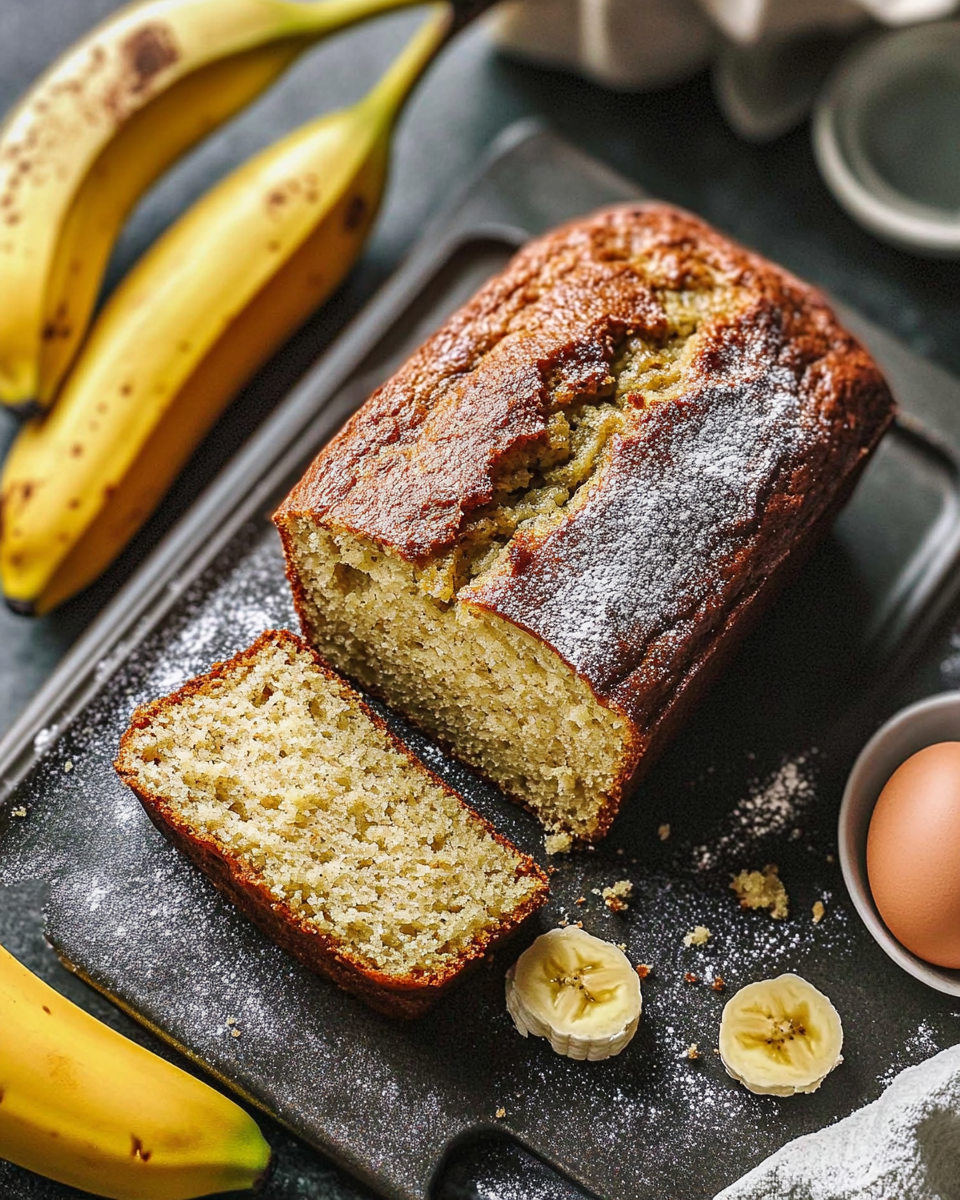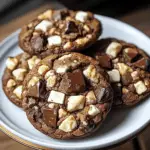The charm of banana bread lies in its simplicity—and this recipe is as classic as it gets. With just a handful of pantry staples and a few ripe bananas, you can whip up a loaf that’s incredibly moist, soft, and bursting with sweet banana flavor.
This banana bread is perfect as a breakfast treat, a midday snack, or a cozy dessert with a dollop of whipped cream. Whether you enjoy it fresh from the oven or toasted with a spread of butter, it’s a timeless favorite that brings warmth and nostalgia to any table.
Full Recipe
Ingredients:
-
3 ripe bananas, mashed
-
1/3 cup melted butter
-
3/4 cup sugar
-
1 egg, beaten
-
1 teaspoon vanilla extract
-
1 teaspoon baking soda
-
Pinch of salt
-
1 1/2 cups all-purpose flour
Directions:
-
Preheat your oven to 350°F (175°C). Grease a 4×8 inch loaf pan.
-
In a mixing bowl, mash the ripe bananas with a fork until smooth.
-
Stir the melted butter into the mashed bananas.
-
Mix in the sugar, beaten egg, and vanilla extract.
-
Sprinkle the baking soda and salt over the mixture and stir to combine.
-
Add the flour last and mix just until incorporated.
-
Pour the batter into the prepared loaf pan.
-
Bake for 50 to 60 minutes, or until a tester inserted into the center comes out clean.
-
Remove from oven and let cool in the pan for a few minutes, then transfer to a wire rack to cool completely.
Prep Time: 10 minutes | Cooking Time: 55 minutes | Total Time: 1 hour 5 minutes
Kcal: 210 kcal per slice | Servings: 10 slices
The Timeless Appeal of Banana Bread
Banana bread has long held a cherished spot in home kitchens across the globe. A comfort food with a humble origin, it transforms overripe bananas into a moist, sweet loaf that’s versatile, forgiving, and incredibly satisfying. Whether it’s your grandmother’s recipe or a modern twist with added nuts or chocolate chips, banana bread evokes nostalgia and comfort in every bite. For many, the smell of banana bread baking is an instant mood-lifter—a scent that speaks of home, warmth, and care.
A Brief History of Banana Bread
The history of banana bread is both practical and interesting. It gained popularity in the United States during the Great Depression, when resourcefulness was key in home kitchens. Overripe bananas, rather than being discarded, were repurposed into a flavorful and frugal treat. With the widespread availability of baking soda and baking powder at the time, quick breads like banana bread became household staples. Its popularity continued to grow through the decades, cemented by its presence in community cookbooks and on the counters of generations of home bakers.
Why Banana Bread is So Popular
There are several reasons why banana bread remains a perennial favorite:
-
Simplicity: It requires minimal ingredients and effort, making it accessible for bakers of all skill levels.
-
Versatility: You can add a variety of ingredients like walnuts, pecans, chocolate chips, cinnamon, or even swirl in cream cheese.
-
Delicious Texture: The natural moisture from ripe bananas creates a soft, cake-like crumb that’s hard to resist.
-
Sustainability: It’s an ideal way to reduce food waste by using overripe bananas that might otherwise be thrown away.
-
Longevity: Banana bread keeps well for several days and can be frozen for future enjoyment.
The Science Behind Its Moist Texture
What makes banana bread stand out from other quick breads is its moist, tender crumb. This is largely due to the high moisture content of bananas. As bananas ripen, their starches convert into sugars and their water content increases, which naturally keeps the bread moist without needing excessive fat or dairy. Additionally, using melted butter and minimal mixing prevents the batter from becoming too tough, which can occur when gluten is overdeveloped.
Flavor Development with Ripe Bananas
One of the key ingredients that make banana bread unique is, of course, bananas. But not just any bananas—ripe, spotty bananas are best. As bananas ripen, their starches break down into natural sugars, which enhances their sweetness and deepens their flavor. This not only improves the taste but also contributes to a richer, more caramelized aroma when baked. The darker the banana, the sweeter and more flavorful the bread will be.
How to Customize Your Banana Bread
Though the classic recipe stands strong on its own, banana bread is highly customizable. Here are a few popular variations:
-
Nuts: Adding chopped walnuts or pecans gives a delightful crunch and earthy flavor.
-
Chocolate Chips: For a sweeter treat, semi-sweet or dark chocolate chips make an indulgent addition.
-
Spices: Cinnamon, nutmeg, or cardamom can add warmth and depth to the flavor.
-
Toppings: Sprinkle turbinado sugar on top before baking for a crackly crust, or drizzle a glaze afterward for extra sweetness.
-
Healthier Versions: Swap in whole wheat flour, reduce sugar, or use coconut oil or Greek yogurt for a lighter version.
Serving Suggestions
Banana bread is incredibly versatile when it comes to serving. Here are a few ideas:
-
Serve warm with a pat of butter or cream cheese for breakfast.
-
Toast slices and top with almond butter and a drizzle of honey for a quick snack.
-
Pair with coffee or tea as a comforting afternoon treat.
-
Use day-old banana bread to make French toast for a decadent brunch twist.
Storing and Freezing Tips
Banana bread stores well at room temperature for up to 4 days if kept in an airtight container. To extend its life, wrap it tightly in plastic wrap or foil and refrigerate it for up to a week. For longer storage, freeze individual slices or whole loaves. Wrap them in plastic wrap and place in a freezer-safe bag. When ready to eat, simply thaw at room temperature or gently warm in a toaster oven.
Why It’s a Family Favorite
What makes banana bread a go-to in so many homes is its reliability. It’s the kind of recipe you can return to time and again, knowing it will turn out well. Children love it for its sweet taste and soft texture, while adults appreciate its nostalgic charm and simplicity. It’s also an excellent recipe to get kids involved in baking—the straightforward steps and instant gratification of a golden loaf make it a perfect introduction to the kitchen.
Health Benefits of Banana Bread (When Made Right)
While banana bread can be an indulgence, it also offers nutritional benefits, especially when tweaked for health-conscious eaters. Bananas are a good source of potassium, vitamin B6, and fiber. By reducing added sugar and incorporating ingredients like whole grain flour, nuts, or seeds, you can enhance its nutritional profile. Even traditional versions, when eaten in moderation, provide energy and a sense of fullness that makes them a smarter choice compared to heavily processed snacks.
Baking Tips for Perfect Banana Bread Every Time
-
Use very ripe bananas for maximum flavor.
-
Don’t overmix the batter—this can lead to dense or rubbery bread.
-
Make sure your oven is preheated to ensure even baking.
-
Test for doneness by inserting a toothpick into the center; it should come out clean.
-
Let the bread cool before slicing to help it set and keep its shape.
Conclusion: A Slice of Comfort in Every Bite
Banana bread is more than just a way to use up overripe bananas—it’s a beloved staple that brings people together through its aroma, flavor, and comforting familiarity. Whether enjoyed with a morning coffee, given as a thoughtful gift, or baked as a weekend ritual, banana bread has a timeless appeal that continues to delight across generations. Its simplicity, adaptability, and sheer deliciousness ensure that it remains a mainstay in kitchens everywhere. Baking banana bread is more than just following a recipe—it’s a little act of love, made golden and warm in your own oven.






